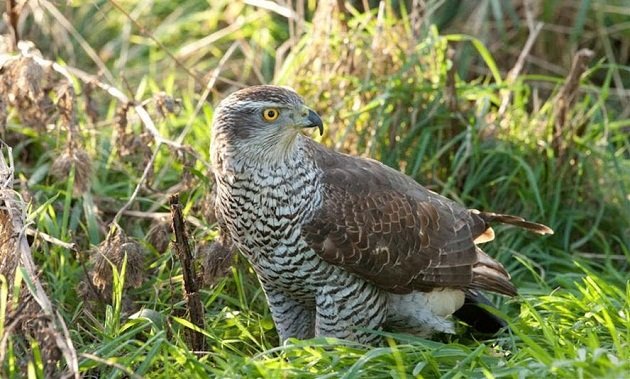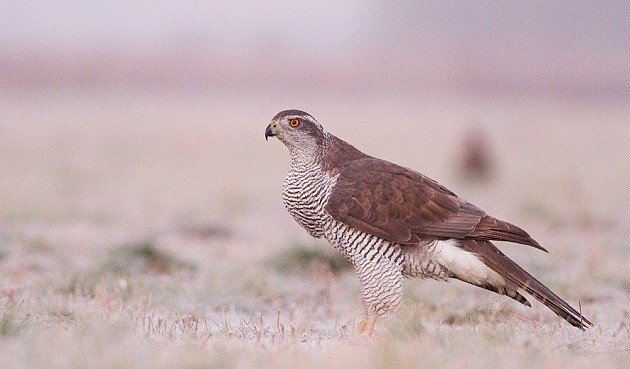
Entering some old data at eBird, I found myself puzzled with one record. I was canoeing the Danube backwaters inside Belgrade, Serbia, on a warm and sunny November day when a Northern Goshawk tried to catch one of two Pygmy Cormorants. The year was 1996 and it must have been quite a sight – if I only could remember it! But no, that sighting is no longer in my head, only on paper. And, now, at eBird.
Yet, one other hunting attempt in the same area I do remember. It took place eight years later, in November 2004 by the bank of the Veliko Ratno Island. Canoeing upriver along the thickets of young White Willows, suddenly there was some squawking and helter-skelter motion in front of me. A female Mallard was running on the water right out of the thickets, flapping its wing frantically. A split-second later, a Goshawk followed in low flight, practically touching the water with its wingtips. The Mallard did something that all dabbling ducks can do but I haven’t seen any of them doing it but this one – it took a dive and disappeared underwater. (My notes of that paddle include some other mouth-watering birds too, such as three Velvet Scoters and two Red-throated Divers.)
The next memorable hunt came from winter 2006/07. I am not sure of the date, still have to find it in one of those notebooks, but I was some 150 miles south of Belgrade, at the Celijsko Dam, counting Eurasian Coots, many of them grazing the banks, very much like domestic chickens would. Among the birds in the shallows, there was one strange sight. A Goshawk, submerged up to its chest, standing in freezing cold water. What is it doing?? Apparently, just standing there. And not moving. So, we sat in a car and waited for it to show us why it was there.
Until we could wait no longer – we had to check the entire dam and count them all, not just those coots. Turning the engine on, approaching for a few more metres… and the Goshawk takes flight. Like some inflatable toy suddenly released of its grip, a black blob pops out the surface – a lifeless Coot. This Goshawk was actually drowning its prey!
 Northern Goshawk in Serbia, (c) Szekeres Levente
Northern Goshawk in Serbia, (c) Szekeres Levente
For the fourth sighing, I have to go back in time, to August 2004, birding the slopes of Mt. Fruska Gora National Park with British journalist Mike Unwin who later described the experience:
“The road passed through a region of short-grass steppe on the lower slopes of the ridge, where we spotted several Sousliks scampering for their burrows. This endearing ground squirrel is the preferred prey of a resident pair of Imperial Eagles… Within twenty minutes, a Goshawk, a Black Kite and two Honey Buzzards passed over. But no eagles appeared; or at least none that I was prepared to tick. … To everyone’s delight, a Saker Falcon soon appeared, offering excellent views as it banked in a long stoop after a hapless distant passerine. …
“Meanwhile, a large dark bird had been spotted atop a distant pylon. … It turned out (sighs of relief all round) to be an adult Imperial Eagle. We watched from about 100 metres away, its white shoulders and golden nape glinting in the late afternoon sun, before its mate arrived and both birds glided off to their roost in a nearby forest.”
I know, how could Mike be impressed by the humble Goshawk when presented with a Saker or a pair of Eastern Imperial Eagles? There is something he didn’t consider worthy of a mention: a Goshawk was sitting at the one third of the height of the very same eagle-topped pylon. That puzzles me – who was the first to perch there, an eagle or the hawk? Did the Goshawk have the nerve to land on the same pylon when the eagle was already there? Or did the Imperial Lady came second and the hawk didn’t dare to leave the perch first?
My dusty notes say that the eagle sat at the top of the pylon for a good three hours, while we had lunch of chicken paprika goulash, washed down with local wine, but I failed to record who left the pylon first. Yet, it must have been quite a tug of nerves.
If I hadn’t written it down back then, the first sighting would no longer exist at all. Until a few days ago, it existed only in my water-wrinkled notebook. And now it and the others are out there, at eBird, like the proverbial truth. If birders are a tribe, as Mark Cocker suggested in his book, they are a part of our tribal memories.
Cover photo: Northern Goshawk in Scotland, by Nigel Wedge / Wikimedia Commons











What a great post! So glad you are taking the time to record your old sightings on eBird and to share them with us here.
Thank you, Karen. It is quite interesting to go through the old field notes; you never know where they may lead you…
I am seeing blank spaces in most places where there are supposed to be pictures on 10,000 birds. This is with Internet Explorer and Firefox. Are there problems with your server?
Yep. Same problem here with Chrome.